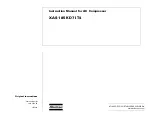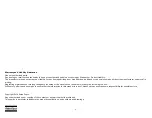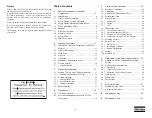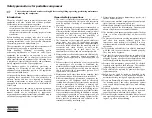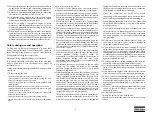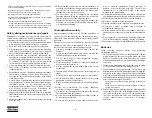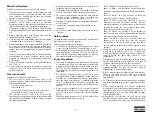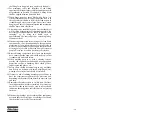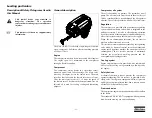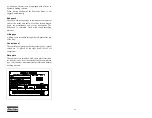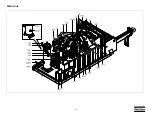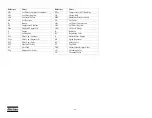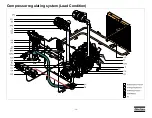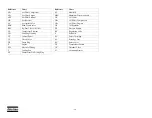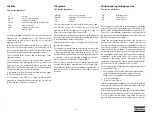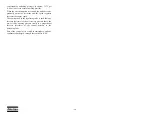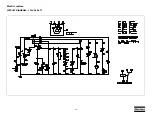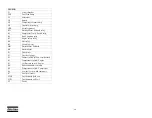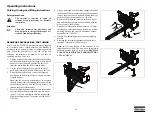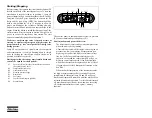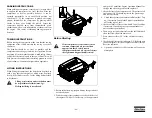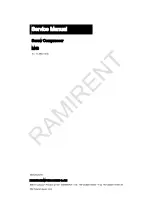
- 8 -
- all hoses and/or pipes inside the unit are in good condition,
secure and not rubbing,
- there are no fuel, oil or coolant leaks,- all fasteners are tight
- all electrical leads are secure and in good order,
- the engine exhaust system is in good condition,
- air outlet valves and manifold, hoses, couplings, etc. are in good
repair, free of wear or abuse,
- the wheel nuts are tightened to the proper torque.
When more than one compressor is connected to a common
header, be sure each compressor has a non-return valve
(check valve) to prevent reverse rotation when stopping.
Safety during maintenance and repair
Maintenance, overhaul and repair work shall only be
carried out by adequately trained personnel; if required,
under supervision of someone qualified for the job.
1 Use only the correct tools for maintenance and repair
work, and only tools which are in good condition.
2 Parts shall only be replaced by genuine spare parts.
3 All maintenance work, other than routine attention,
shall only be undertaken when the unit is stopped.
Ensure that the unit cannot be started inadvertently
4 Before removing any pressurized component, the
compressor or equipment shall be effectively isolated
from all sources of pressure and the entire system shall
be relieved of pressure. Do not rely on non-return
valves (check valves) to isolate pressure systems.
5 Never use flammable solvents for cleaning (fire-risk).
Take safety precautions against toxic vapours of
cleaning liquids.
6 Scrupulously observe cleanliness during maintenance
and when performing repairs. Keep dirt away by
covering the parts and exposed openings with a clean
cloth, paper or tape.
7 Never weld on or perform any operation involving heat
near the fuel or oil systems. Fuel and oil tanks must be
completely purged, e.g. by steam-cleaning, before
carrying out such operations. Never weld on, or in any
way modify, pressure vessels. Disconnect the
alternator cables during arc welding on the unit.
8 Support the drawbar and the axle securely if working
underneath the unit or when removing a wheel. Do not
rely on jacks.
9 Make sure that no tools, loose parts or rags are left in
or on the unit.
10 Before clearing the unit for use after maintenance or
overhaul, check that operating pressures, temperatures
and speeds are correct and that the control and
shutdown devices function correctly.
11 Do not remove any of, or tamper with, the sound
damping material. Keep the material free of dirt and
liquids such as fuel, oil and cleansing agents.
12 Protect the electrical and regulating components, the
air filter, etc. to prevent moisture from entering them,
e.g. when steamcleaning.
Tool applications safety
Apply the proper tool for each job. With the knowledge of
correct tool use and knowing the limitations of tools,
along with some common sense, many accidents can be
prevented.
Special service tools are available for specific jobs and
should be used when recommended. The use of these
tools will save time and prevent damage to parts.
1 Use only wrenches or sockets whose size fits the
fastener.
2 Apply an open-end wrench only in the place of the
fastener head, square to the thread axis.
3 Do not use a pipe or other improvised leverage
extensions on handles.
4 Do not hammer on wrenches or other tools which are
not specially designed for it.
5 Always support the ratchet head when using socket
extensions.
6 Discard any wrench with broken or battered points or
edges.
7 Never use hand type sockets on power or impact tools.
8 Select only heavy-duty impact sockets for use with
pneumatic or electric impact tools.
9 Replace sockets showing cracks or wear; keep sockets
clean.
10 Never use screwdrivers for prying, punching,
chiseling, scoring or scraping.
11 Use the correct type and size of screwdriver for the job.
The bit must match the fastener.
12 A screwdriver with rounded edges will slip; it needs to
be redressed or discarded.
13 Never use a screwdriver or any other tool near a live
wire or electrical component. Plastic covering of
handles is for comfort and grip only. They are not
intended to act as insulation if such is not clearly
marked by the manufacturer.
14 Never strike a hammer against a hardened object; use a
soft drift against the object and strike against the drift.
15 Strike the object with the full face of the hammer.
16 Never use a hammer with a loose head.
17 Discard a hammer with chipped or mushroomed face.
18 Never use a chisel or punch with a chipped or
mushroomed striking face.
19 Always pull on a wrench or socket handle, if possible,
and adjust your stance to prevent a fall if something lets
go.
20 Wear approved eye protection when using percussion
tools or when scraping, chipping, shaving or grinding.
21 Wear protective gloves when holding a chisel or punch.
Batteries
When servicing batteries, always wear protecting
clothing and glasses.
1 The electrolyte in batteries is a sulphuric acid solution
which is fatal if it hits your eyes, and which can cause
burns if it contacts your skin. Therefore, be careful
when handling batteries, e.g. when checking the charge
condition.
2 Install a sign prohibiting fire, open flame and smoking
at the post where batteries are being charged.
3 When batteries are being charged, an explosive gas
mixture forms in the cells and might escape through the
vent holes in the plugs. Thus an explosive atmosphere
may form around the battery if ventilation is poor, and
can remain in and around the battery for several hours
after it has been charged. Therefore:
- never smoke near batteries being, or having recently been,
charged,
- never break live circuits at battery terminals, because a
spark usually occurs.
4 When connecting an auxiliary battery (AB) in parallel
to the unit battery (CB) with booster cables: connect
the + pole of AB to the + pole of CB, then connect the
- pole of CB to the mass of the unit. Disconnect in the
reverse order.
Incorrect connection will damage
alternator.
Summary of Contents for XAS 185 KD7 IT4
Page 1: ...XAS 185 KD7 IT4 Instruction Manual for AC Compressors English Engine Kubota V2403 M DI E3B ...
Page 2: ......
Page 13: ... 13 Main Parts ...
Page 15: ... 15 Compressor regulating system Load Condition ...
Page 19: ... 19 Electric system CIRCUIT DIAGRAM 1310 3200 71 ...
Page 27: ... 27 ALTITUDE UNIT PERFORMANCE CURVE ...
Page 33: ... 33 Adjustments and Servicing Procedures Adjustment of the Continuous Regulating System ...
Page 40: ... 40 ...
Page 41: ......
Page 42: ...www atlascopco com ...


